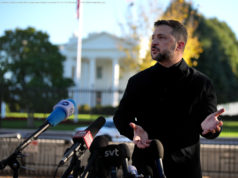Thomas Jefferson’s stage fright! Woodrow Wilson’s academic research on presidential rhetoric! Reagan’s special guests!
The State of the Union address feels like a very old American ritual, and it is. Yet many of its features that we take for granted today were in fact added by innovative presidents who decided to shake things up — sometimes for very idiosyncratic reasons.
There was Thomas Jefferson, who delivered the speech only in writing— perhaps because he was a terrible public speaker. There was Woodrow Wilson, who put his political science theories on presidential rhetoric into practice by reviving the in-person speech. And there was Ronald Reagan, who took advantage of television to show off special guests sitting in the crowd.
So while President Trump prepares for a familiar routine — standing in front of the vice president and the House speaker to offer his take on the state of America — here’s a rundown of how massively the speech has actually changed over time.
A statue of Thomas Jefferson in the Capitol. (Bill Clark / CQ-Roll Call Group / Getty)
For the first 12 years of the United States, Presidents George Washington and John Adams delivered the president’s message much like today’s presidents do — they traveled to Congress and gave an oral speech to them. (Throughout most of US history, what we now know of as the State of the Union address was called the president’s annual message.)
But when Thomas Jefferson took office in 1801, he decided to change things — and send only a written message rather than going to give a speech. Publicly, he said that such a change would take up less of the legislators‘ time, and prevent them from feeling pressured to come up with their own response. The spectacle of a president addressing Congress had also seemed to some Republicans „altogether too reminiscent of the monarch’s speech from the throne at the opening of Parliament,“ wrote historian Daniel Walker Howe.
However, a 1995 article by Gerhard Casper, then president of Stanford University, argues that Jefferson may have had a more personal reason to make the change — his shyness. Casper writes:
Casper concludes that Jefferson’s decision was probably partly based on a genuine desire for reform „that was aligned with self-interested desire to avoid public speaking.“
Woodrow Wilson speaks to Congress during his 1915 State of the Union address. (Universal History Archive / UIG / Getty)
For over a century, every president would follow Jefferson’s example, and send only a written annual message to Congress. But a young political scientist by the name of Woodrow Wilson wasn’t convinced. Wilson had long been interested in how presidential rhetoric could be more effectively used, and in 1889, Wilson wrote that Jefferson should never have made the switch, since an oral presidential message could have allowed a „more public and responsible interchange of opinion between the Executive and Congress.“
When Wilson himself became president in 1913, he had the opportunity to put his ideas into action. As a special session of Congress was about to begin that April, Wilson decided that he’d address them personally to promote his agenda. „The announcement stunned official Washington,“ Robert Kraig wrote in a book on Wilson. Kraig writes that a contemporary press account portrayed Congress as „astonished,“ and that even members of Wilson’s Cabinet were doubted the wisdom of the move.
But the speech — which technically wasn’t an „annual message“ — went over well, and press coverage was positive. So when the traditional time for Wilson’s first message arrived in December, he delivered that as an in-person speech too. He’d deliver five more in-person annual messages, before reverting to written messages for his final two due to bad health. Presidents Coolidge and Hoover would revert to mostly written messages, but FDR would make an in-person — and nationally broadcast — speech the norm.
FDR, before he became president. (Hulton Archive / Getty)
Article II, Section 3 of the Constitution says that the president shall „from time to time give to the Congress Information of the State of the Union, and recommend to their Consideration such Measures as he shall judge necessary and expedient.“ But for nearly a century and a half, that catchy term „State of the Union“ wasn’t used as a title, with the more anodyne „annual message“ preferred instead.
It was FDR who started giving the term „state of the union“ increased prominence, particularly starting in January 1942, shortly after the US entrance into World War II. According to the House of Representatives clerk’s office, FDR’s speech then „began to be informally called the ’state of the Union‘ message/address.“ A few years later, President Truman officially named it the „State of the Union Address,“ and that name has stuck since.
In January 1982, a plane crashed into Washington, DC’s 14th Street Bridge and fell into the Potomac River, killing 78 people. In the chaos, Congressional Budget Office employee Lenny Skutnik jumped into the river and helped rescue a passenger. So the Reagan Administration invited Skutnik to the State of the Union address two weeks later — where the president personally praised him for his heroism. Members of Congress gave him a standing ovation, as TV cameras panned over to Skutnik (one caption read: „Plane Crash Hero“).
Reagan and future presidents would soon expand this practice to include not just heroes, but ordinary Americans whose stories (and faces) could help illustrate one of the speech’s points. DC wags would soon dub these guests “ Skutniks.“ In the words of reporter Jeff Greenfield, „A skutnik is a human prop, used by a speaker to make a political point.“
The practice of inviting Skutniks has been enthusiastically embraced by the Trump administration. This year, Trump will invite the parents of two girls murdered by the gang MS-13, a Marine Corps corporal who reenlisted after being blinded and losing his limbs to an IED, and the organizer of the „Cajun Navy“ that rescued victims of Hurricane Harvey.
Political pundits often exaggerate how influential presidential speeches can be. The president has little power to change Congressional minds and win support for controversial bills with rhetoric alone. Even the public won’t likely move much — according to Gallup’s Jeffrey Jones, State of the Union speeches „rarely affect a president’s public standing in a meaningful way, despite the amount of attention they receive.“
But some have truly stood the test of time — particularly those that signal a major change in foreign policy, where the president has more room to act on his own.






